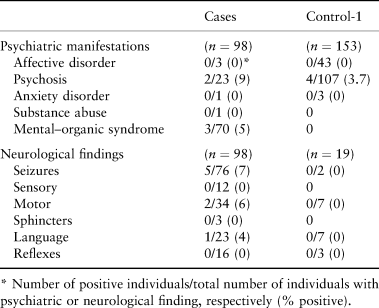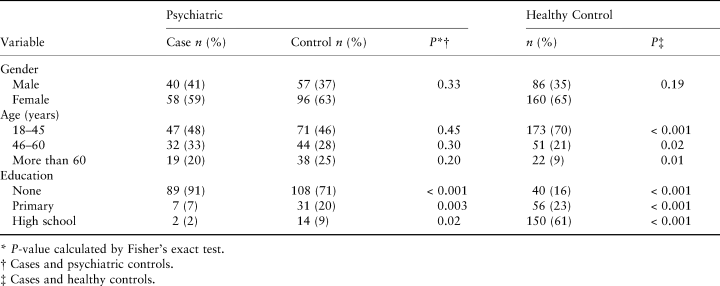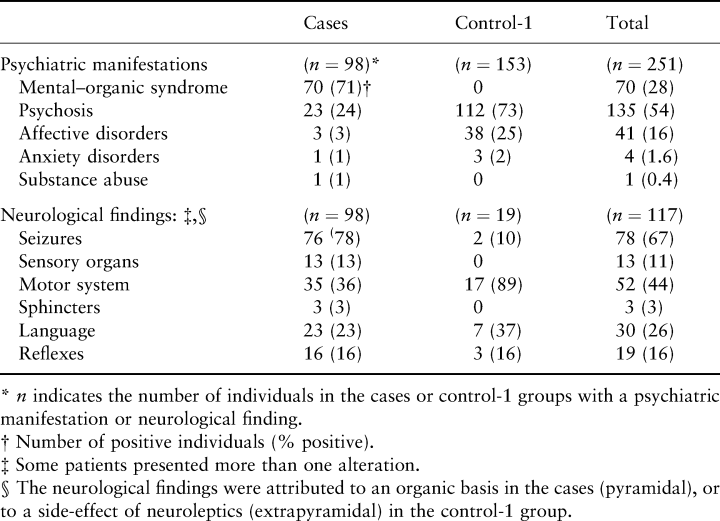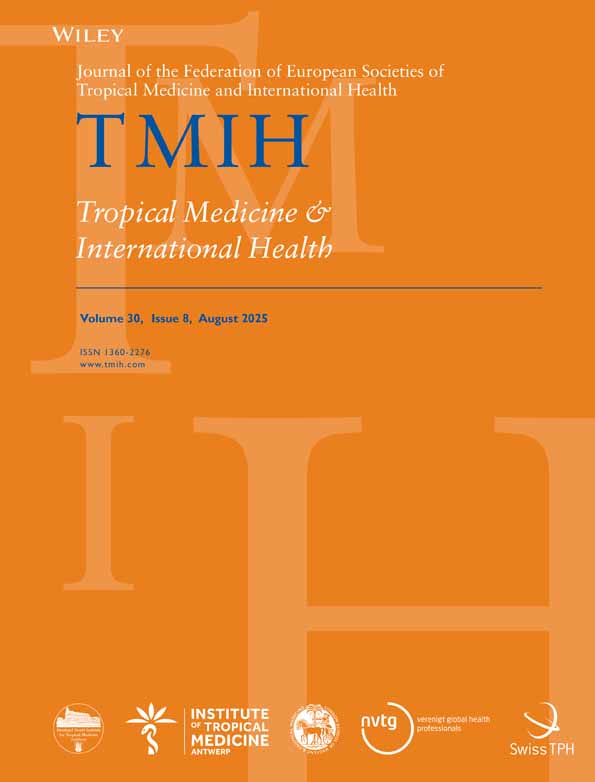Serological screening for cysticercosis in mentally altered individuals
Abstract
The parasitic infection neurocysticercosis may give rise to a variety of psychiatric manifestations that resemble, but are different from, primary psychiatric disorders. The aim of this study was to determine if among individuals from a neurocysticercosis-endemic area of Colombia who apparently had a psychiatric manifestation with associated neurological finding (`cases'), some could have been infected with Taenia solium cysticerci. This case–control study was done in individuals hospitalized in two mental institutions. The control-1 individuals were those classified with primary psychiatric disease, and the control-2 group consisted of healthy, non-hospitalized individuals. A serological test for cysticercosis was positive in 5/96 (5.1%) cases, 4/153 (2.6%) psychiatric controls, and 5/246 (2%) healthy controls. The data analysis indicated a weak association between the cases and a positive serology for neurocysticercosis (odds ratio > 2; P > 0.05). The lower education level of the cases influenced this association.
Introduction
Cysticercosis (CC) is caused by the metacestode stage or cysticercus of the parasite Taenia solium in humans and pigs. In humans, the central nervous system infection of the metacestode is referred to as neurocysticercosis (NCC), while the intestinal infection with the adult T. solium is known as taeniosis. This fecal–oral infection is transmitted between humans by free ranging pigs are raised under inadequate sanitary conditions (Flisser et al. 1982). NCC occurs primarily in the developing countries of Latin America (including Colombia), Africa and Asia. It causes an estimated 50 000 deaths per year, and leaves many of the surviving patients permanently disabled by recurrent seizures or other neurological damage (Schantz1999).
The clinical spectrum of NCC can range from asymptomatic (up to 44%) to life threatening (Botero et al. 1993). The most common clinical manifestations are late onset seizures, signs and symptoms associated with increased intracerebral pressure, focal neurological findings (e.g. aphasia, visual loss), chronic meningitis and altered mental state (Shriqui & Milette 1992; Botero et al. 1993; Forlenza et al. 1997). The latter category affects 9–65% of NCC patients, depending on the literature cited, with the most frequent manifestations being dementia and confusion (Botero 1994; Sotelo et al. 1996; Forlenza et al. 1997). In Brazil, Forlenza and collaborators found a variety of psychiatric manifestations that included affective disorders, chronic psychosis, neurotic alterations, personality disorders and depression, in addition to cognitive decline (Forlenza et al. 1997). Even though NCC is known to be one of the causes of organic psychosis, the real magnitude of the problem could vary depending on the place of origin of the patient (Gorman & Cummings 1990; Tavares 1993). Therefore, in villages where NCC is endemic, a probable NCC should be considered in the individuals with mental alterations.
The purpose of this study was to establish if there is an association between a positive serology for NCC and the presence of psychiatric manifestations in patients from two mental hospitals located in an NCC-endemic region in Colombia. The experimental group consisted of hospitalized patients classified as having a secondary psychiatric disease, and the control groups were either patients from these same institutions but with primary psychiatric disorder (control-1), or healthy, non-hospitalized individuals from the same region of Colombia (control-2). The serum specimens obtained from the patient and control groups were analysed for the presence of antibodies against T. solium metacestodes by a Western blot assay and an association between a positive serology and the cases and controls was sought.
Materials and methods
Study design
An institutional case–control study was performed. The experimental and control-1 groups consisted of individuals with psychiatric manifestations in the mental hospitals Perpetuo Socorro (for females) and San Rafael (for males) in San Juan de Pasto-Nariño, Colombia. The inclusion criteria were age range of 18–85 years, hospitalized between the months of May and June of the year 2000, and having lived for at least 5 years in the south-western region of Colombia (departments of Nariño, Cauca, Putumayo and Valle del Cauca). These included patients that were in the hospital temporarily or permanently (for years). The geographical selection of the patients was based on previous reports that indicated that NCC occurs in the individuals from the south-western departments of Colombia (Sanzón-Guerrero et al. 1991; Bonelo et al. 1992; Sanzón et al. 2000). The individuals fulfilling these inclusion criteria were invited to participate, and those (or their legal guardians when applicable) who voluntarily accepted signed an informed consent, were bled, and underwent a psychiatric and neurological examination as described below. The study was approved by the Ethics Committee from the Corporación para Investigaciones Biológicas.
The psychiatric population was divided into two study groups: the `cases' had neurological findings with evidence of an organic problem. This category could include NCC patients (Gorman & Cummings 1990). This classification was reached after excluding the possibility that the neurological symptoms were because of a secondary side-effect of the medication taken by the patient at the time of the study. Particular attention was given to neuroleptics that could cause a Parkinson-like effect. All the other psychiatric individuals were classified in the control-1 group because they appeared to have a `primary' psychiatric illness. This conclusion was based on the presence of a neurological finding that could be attributed to a side-effect of the medication taken at the moment, or the absence of neurological abnormalities.
A second control group (control-2) was selected from the outpatient (non-psychiatric nor neurological) population and the employees of a neighbouring hospital in San Juan de Pasto, the San Pedro Hospital. These were randomly selected females or males aged 18–85 years who worked in the hospital during the months of May and June of the year 2000. These individuals submitted to a similar psychiatric and neurological examination, and only those with normal findings were invited to participate.
Psychiatric and neurological evaluations
The classification of the psychiatric manifestations was mainly based on the previously established classification of their mental illness, which was done by the psychiatrist in charge of both hospitals. In addition, a mini-mental state examination, present state examination, the schedule for affective disorders, the schizophrenia-lifetime version, and the Strub and Black mental status examination was performed by two medical interns to re-affirm the diagnosis (American Psychiatry Association 1994).
The presence of neurological signs and symptoms was assessed with a neurological physical examination and complemented with the medical history of each patient. The administration of medications that could affect the neurological findings was taken into consideration to classify the patients into cases or control-1 groups, as described above. Unfortunately, it was not possible to complement the neurological examination with results from previous imaging studies because this information was not available for most patients. The control-2 individuals with neurological abnormalities on the physical examination were excluded from the study.
Two medical interns performed the psychiatric and neurological evaluations. Prior to this they were trained to perform the questionnaire and medical evaluations by professional psychiatrists and neurologists. After the patient evaluations were done, each medical history was analysed by the interns and specialists to determine the final classification of each patient into the experimental and control groups.
Immunoassay
A previous exposure and/or current infection with T. solium cysticerci was examined by detecting antibodies against this parasite using a previously described Western blot analysis that uses an extract enriched for glycoproteins (GP-Western blot) (Restrepo et al. 2000). The sera from the patients and controls were evaluated at a 1 : 200 dilution. Detection of an antigen-antibody reaction was carried out with a secondary antibody labelled with alkaline phosphatase, and development of the reaction was done with the substrates nitroblue tetrazolium and 5-bromo,4-chloro-3-indolyl phosphate. A positive and a negative control were done for each experiment. The serology for CC was considered positive if there were detectable antibodies against one or several of the five glycoproteins of 12, 16, 18, 24 and 28 kDa. The only exception was for reactions presenting a faint 12 kDa band alone, because this reaction can also occur in some of the NCC-negative specimens (Blanca I. Restrepo and Diana I. Gómez, unpublished findings). Preliminary data with 50 sera from NCC positive and negative patients who had a well-documented medical history showed a similar performance of our immunoassay and the previously described electroimmuno-transfer blot (Qualicode Cysticercosis Kit) (Immunetics, Cambridge, MA, USA) (Tsang et al. 1989; Wilson et al. 1991). The results from faint-positive reactions in this study were verified with the commercial version of the electroimmuno-transfer blot (Qualicode Cysticercosis Kit).
Radiological studies
The interpretation of a positive serology for NCC was complemented with a head computer tomography (CT) with and without contrast enhancement. These procedures were a kind donation of the MEDINUCLEAR Radiology Group (Pasto, Nariño-Colombia). The physical and radiological studies did not evaluate the probable presence of extra-cerebral cysticerci.
Statistical analysis
The database and statistical analysis was done with SPSS 8.0 statistical software for Windows (Chicago, IL, USA). The differences between the cases and control-1 and control-2 groups were determined by Fisher's exact test. An association between two variables was determined by estimating the odds ratio and their 95% confidence intervals. Analysis of possible confounders was done with a logistic regression analysis model. The significance level was established at 0.05.
Results
General data from the patient and control population
Four hundred and ninety-seven individuals were studied. Those from the experimental and control-1 groups were inpatients in the mental hospitals Perpetuo Socorro for females (n=314), and San Rafael for males (n=183). Ninety-eight were in the experimental group based on the presence of a psychiatric disorder and a neurological condition that was presumed to be secondary to an organic alteration. One hundred and fifty-three were classified as control-1 based on the presence of psychiatric findings and either absence of neurological findings (134 cases) or likelihood that the neurological findings detected could be because of a secondary effect of the medication taken at the time of the study (19 cases). The control-2 group consisted of 246 healthy, non-hospitalized individuals with no evidence of psychiatric or neurological alterations based on the neuropsychiatric evaluation performed in this study. Table 1 indicates the socio-demographic characteristics of the three study groups. There were no differences in gender between the cases and control-1 or control-2 groups (P=0.33 and 0.19, respectively). The psychiatric patients comprising the cases and control-1 groups shared similarities in their age distribution, but the cases were significantly older than the healthy individuals (P=0.02). Finally, the cases had a lower level of education than the control-1 (P=0.02) or the healthy control-2 (P < 0.001) group.
Psychiatric findings
The psychiatric findings were classified into affective disorders (depression, bipolar disorder, depressive psychosis), psychosis (schizophrenia, schizoaffective disorder, schizophrenoid alteration), anxiety disorders (obsessive-compulsive, post-traumatic stress syndrome, panic disorder, phobias), mental–organic syndrome (delirium, dementia), and alcohol and drug abuse. The most common findings were a mental–organic syndrome (71%) and psychosis (24%) in the cases, and psychosis (73%) and affective disorders (25%) in the control-1 group (Table 2).
Neurological findings
The neurological examination comprised a history of seizures and an evaluation of the sensory organs, motor system, sphincters, language and reflexes (Table 2). An abnormal condition was found in 117 cases. From these, the neurological findings from 19 patients could be potentially attributed to a side-effect of the medications (particularly neuroleptics) taken by the patient (control-1 group), and the remaining 98 were thought to be because of an organic problem (cases). In the latter cases the underlying factor could not be established, except for one case of neurosyphilis. Some patients presented more than one neurological finding, and the most common were seizures in 76 (78%), altered motor system in 35 (36%), and language problems in 23 (23%) of the cases, and motor in 17 (89%) and language alterations in 7 (37%) of the control-1 group (Table 2).
NCC serology in the experimental and control groups
The GP-Western blot was positive in five of 98 experimental (5.1%), four of 153 control-1 (2.6%), and five of 246 control-2 cases (2%) (Figure 1; Table 3[link]). There was a weak, non-significant association between a positive serology for NCC and the presence of a mental–organic syndrome (cases) when compared with the control-1 group (odds ratio=2; P=0.3; 95% confidence interval 0.5–7.6), or the healthy control-2 group (odds ratio=2.6; P=0.126; 95% confidence interval 0.7–9.1). An interesting aspect of the serology is that there were variations in the number of the positive bands between the groups (Figure 1). A reactivity with the five glycoprotein antigens was detected in three of the 98 cases, and none of the control-1 or control-2 groups (P=0.03 and 0.006, respectively) (Figure 1).


Western blot for neurocysticercosis (NCC) in the patients and controls with a positive serology. Antibodies against a glycoprotein-enriched fraction of Taenia solium cysticerci were detected in five cases, four control-1 and five control-2 patients. Serum from a NCC patient (positive control; C+) and a healthy individual (negative control; C−) were used as reference. The location of the 12, 16, 18, 24 and 28 kDa glycoproteins is indicated. The relative molecular mass (Mr) of the glycoproteins is indicated in kilodaltons.
Given the differences in age and educational level between the experimental and control groups (Table 1), the influence of these possible confounders on the positive serology for NCC was determined using a logistic regression model. The dependent variables were to be a case or a control (two separate analyses were run for each control group), and the covariates were serology, educational level and age. In these analyses the association between a positive serology for NCC and being a case or a control was decreased to an odds ratio of 1.5 (P=0.5) and 1.1 (P=0.87) when comparing the experimental with the control-1 and control-2 groups, respectively. This decrease in the strength of the association was influenced by the differences between the education level of the groups (odds ratio=2.8; P=0.001 for control-1 and odds ratio=14.4; P=0.001 for the control-2), but was not affected by the age.
A positive serology for NCC was present in patients with various types of psychiatric manifestations such as psychosis (two cases and four patients in control-1 group) and mental–organic syndrome (three cases) (Table 3). Regarding the neurological findings, the five cases with a positive serology had seizures, and in addition two had a simultaneous motor and one a language disability (Table 3).
Radiological studies in cases with positive serology
A simple and contrasted head CT was done for most of the individuals with a positive serology to look for lesions suggestive of NCC. This was possible in three of the five cases, and three control-1 and control-2 individuals. The rest were not done because the individual died (one case), could not be found (one case, control-1 and control-2) or had a faint-positive reaction (one control-1; one control-2). The radiological study did not reveal lesions suggestive of NCC in any of the individuals (data not shown).
Discussion
At the beginning of the century, primary and secondary psychiatric diseases were difficult to distinguish and the mental hospitals had an important proportion of individuals with organic mental syndromes, including NCC (Tavares 1993; Sotelo et al. 1996). With the advent of head CT and/or magnetic resonance imaging, and the improvement of serological assays, the detection of central nervous system tumours and infections has been facilitated. Today, most individuals with NCC are promptly treated and mental hospitals are no longer a common place for these patients. Despite these advances, in rural areas of the world where NCC is endemic, like San Juan de Pasto-Colombia, there are still limitations in the medical technology, deficits in the funding of the social medicine, and lack of medical doctor specialists, that make the distinction between primary and secondary psychiatric disorders more difficult (Sanzón-Guerrero et al. 1991; Sanzón et al. 2000). San Juan de Pasto has 371 000 habitants and two mental hospitals with a total of 710 beds. Even though these two institutions are reference centres in Colombia for mentally ill patients, about 80% of the inpatients are from the south-western region of the country where NCC is common (Sanzón-Guerrero et al. 1991; Sanzón et al. 2000). In this institutional case–control study, inpatients from the two mental hospitals of San Juan de Pasto underwent systematic serological screening for NCC. The data indicated that there was a weak and non-significant association between a positive serology for NCC and having a secondary psychiatric disease. This association was largely influenced by the lower education level of the cases. Interestingly, the highest antibody titres (strong reaction with the five antigens) were only detected in three cases, but not in the two control groups.
Determining an association between NCC and psychiatric manifestations is important because prompt treatment with anthelminthics may improve the patient's mental condition. This is more notable in patients with cysticercotic encephalitis because of an increased intracranial pressure due to massive cysticerci infection (Sotelo et al. 1996), but can also occur in patients with few cysticerci (Herbert B. Tanowitz, personal communication). In this study there was no evidence that suggested this possibility in the cases. While the serological data indicated that an infection with T. solium was more frequent and intense (strong reaction with the five antigens) in the cases (organic and psychiatric findings), the head CT did not show evidence of lesions suggestive of NCC in any case or control. Also, in two of the cases with a strong serology a follow-up CT scan after anthelminthic treatment did not reveal lesions compatible with NCC (data not shown). This apparent discordance between the serology and the CT may be explained by: (i) an extracerebral infection with T. solium, (ii) the presence of viable cysticerci in the brain which were not detected with CT scans, (iii) a temporary positive serology that is not associated with a well-established infection in the brain (Garcia et al. 2001) and/or (iv) a false-positive reaction despite the 98% specificity displayed by our immunoassay (our unpublished findings).
Several aspects should be analysed in the design of this study. The serology for CC is used routinely as a screening method in epidemiological studies, but its results should be interpreted with caution. These assays are ideal for detecting active NCC, but not sensitive enough for identifying individuals with single, calcified cysts located in parenchyma (Tsang et al. 1989; Wilson et al. 1991). The literature indicates that this latter group of patients frequently have seizures (Rajshekhar & Chandy 1997), which was the most common neurological finding in the `cases' with mental–organic syndrome in the present study. Given the chronic nature of the mental disorders from the patients studied (10 years on average), it is possible that some of the patients with a mental–organic syndrome did have residual calcified lesions from a past NCC infection. However, at this stage the patients usually have an undetectable humoral immunity (Wilson et al. 1991) and therefore this population could not be evaluated in this study. A second consideration in the design of this study was that a precise classification of the psychiatric disease was not attempted, as this would require the opinion of different psychiatrists as well as an extended follow-up of the patients. Finally, we are aware that the classification of psychiatric patients into cases or control-1, based on the physical neurological examination, medical history, and medications taken at the time of the study, provided a close approximation to distinguish these two patient populations. However, it would have been ideal to complement these data with head CT but this was not possible because of the lack of this information in the medical history, and the high costs involved.
In this study the positive serology for NCC was associated with a lower level of education in all the psychiatric patients. One possibility is that this group of individuals had a poor hygiene, making them more prone to faecal–oral infections such as NCC. Another feature of the psychiatric patients with a positive serology for NCC was the coexistence of seizures. This observation is similar to the findings from non-psychiatric patients, where seizures are recognized as the most common manifestation of NCC (Sotelo et al. 1985; White 2000).
In summary, this study did not provide solid evidence to suggest that NCC could cause the mental alterations in the psychiatric patients studied. However, it did alert the medical community of San Juan de Pasto to the importance of performing the relatively inexpensive and simple serological assay for NCC upon admission to the mental hospital, especially when neurological findings are evident. The immuno-screening may contribute to the early detection of an active NCC, and a prompt treatment against this parasitic infection could benefit these patients.
Acknowledgements
We thank Dora L. Gil and Diana I. Gomez for their help with the serological studies, Dr Jorge Holguín for the training during the psychiatric examination, Dr Diego Cadavid and the reviewers from the Sustainable Sciences Institute for a critical review of the proposal, and Drs Clinton White Jr and Herbert Tanowitz for their enthusiastic support to carry out this study. This study was supported by the Sustainable Sciences Institute and the Universidad de Nariño. The computarized tomographies were a kind donation of the Fundación Valle de Atriz-Radiólogos.






